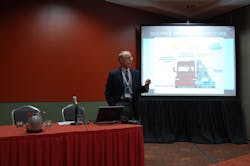Biggest crash risk indicators not always addressed by regulations
SAN ANTONIO. Driver personality type, traffic density, and low average speeds are just some of the more accurate indicators of crash risk for heavy trucks yet are metrics rarely covered by trucking regulations – meaning compliance with rules may not be enough on its own to significantly mitigate crash risks for carriers.
That’s the conclusion of Dr. Ron Knipling, a 30-year traffic safety research veteran and currently president of consulting firm Safety for the Long Haul Inc. During a presentation here at the 2014 Zonar Systems user conference, he noted that driver personality – especially aggressive “Type A” behavior patterns – is a far stronger crash risk factor than medical conditions such as sleep apnea, cardiovascular disease, obesity, and diabetes.
Research has also shown that “non-driving” criminal behavior is also a strong crash risk indicator, with studies showing a person guilty of criminal behavior outside of motor vehicle operation has a two-times greater crash risk compared to non-criminals.
Yet Knipling said the two biggest “red flags” in term of crash risk for drivers are their involvement in single-vehicle crashes and non-use of safety belts.
He noted that in the case of drivers involved in solo versus multi-vehicle crashes, they are 32 times more likely to have fallen asleep behind the wheel in single vehicle crashes, eight times more likely to suffer from physical impairment of some sort, six times more likely to have been speeding, 10 times more likely to be aggressive drivers, and three times more likely to not be wearing seat belts.
In terms of non-use of seat belt usage, 23% of truck drivers involved in single-vehicle crashes were not wearing them, with 8% not wearing them in at-fault multi-vehicle crashes and 6% in not at fault multivehicle crashes. "Unbelted drivers are also three times more likely to be injured in a crash versus belted drivers,” he added. “So it’s not just about them clicking the belt; it’s also a marker of their crash risk.”
Parsing data from the $20 million large truck crash causation study (LTCCS) conducted by the Federal Motor Carrier Safety Administration (FMCSA) 10 years ago, noted some other crash risk markers:
- Trucks operating on undivided roadways are at a 5.3-fold higher risk of crashing versus those operating on divided highways at steady speeds
- Trucks driving in heavy traffic are at a 5.9-fold higher risk of crashing versus medium to light traffic levels
- There’s an 8.5-fold higher risk of crashes for trucks operating in highway work zones
- Trucks driving at speeds of 50 mph or lower are at an 8.9-fold risk of crashing versus those driving 51 mph or higher. That’s largely because those slower speeds are in response to heavy traffic, operation on undivided roads, etc.
Knipling also pointed to what he called the “Big 3” in terms of the types of crashes heavy trucks are most frequently involved in: Road departure and rollovers, where excessive speed is the main culprit 21% of the time; rear-end crashes, where recognition failure on the part of the truck driver (31%), degraded brakes (19%) and physical impairment of the driver (10%) are the main culprits; and lane change/merge crashes, the type with the greatest “over-involvement” by heavy trucks.
“Left-to-right lane changes and merging are the most problematic for trucks especially as those types have the poorest line-of-sight for drivers,” he explained, noting that in 61% of those types of crashes cases where the truck was at fault, inadequate surveillance was the main reason, followed by going too fast (13%) and misjudgment of the spacing gap (6%).
Knipling concluded that while compliance with safety rules is essential, existing regulations mainly focus on the physical aspects of the truck driver and vehicle issues, which are only factors in 6% of large truck crashes, respectively, according to FMCSA’s data.
“Carriers with the highest level of safety are the ones that go beyond just compliance with the rules,” he added. “The proactive capability of the carrier is what’s critical here.”
About the Author
Sean Kilcarr
Editor in Chief
Sean Kilcarr is a former longtime FleetOwner senior editor who wrote for the publication from 2000 to 2018. He served as editor-in-chief from 2017 to 2018.
